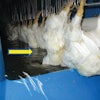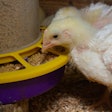
Over the coming month or so, temperatures are likely to remain high in the Philippines — and even climb to dangerous levels as a heat wave strikes the Asian continent.
A prolonged hot and dry spell has already affected supplies of chicken and eggs, and resulted in massive crop losses in one region.
Not only are these heat waves a threat to human health, they are also expected to impact animals adversely, according to Inquirer. Food-producing animals will be no exception, and production is likely to dip.
Over the coming weeks, the national weather administration is forecasting temperatures widely over 40C, with humidity levels pushing up the heat index by a further 2-3C. However, one meteorological expert said some areas of the country could reach 52C — or even higher — in May.
These temperatures are considered to be dangerous for health, he said, and warned that people outside need to take precautions.
Earlier this week, the Department of Agriculture reported that President Ferdinand Marcos, Jr had visited the western island region of Mimaropa to see for himself the impacts of the recent drought brought by the current El Niño phenomenon.
With five towns already declared a “state of calamity,” he committed government assistance to provide relief to help mitigate the impacts on farming.
In two provinces alone, around 8,500 farms have suffered damage as a result of the lack of rainfall. Already, crop losses are estimated as more than 38,000 metric tons valued at over one billion pesos (PHP; US$18.1 million).
High temperatures impact meat, egg production
As a result of their rapid metabolism and growth potential, ruminants, pigs and poultry are especially susceptible to heat stress, according to the authors of one study cited in the Inquirer article. Furthermore, they said, rumen fermentation, an inability to sweat, and insulation from the coat or feathers add to the animals’ difficulties in regulating their body temperature.
In a separate review paper are highlighted the adverse effects of chronic or acute heat stress prior to slaughter on meat quality.
For poultry, another experiment found a significant reduction in daily feed intake when heat stress conditions were applied for a period of 12 days. As a result, egg production dropped by almost 30%. Extreme heat was also associated with a reduction in eggshell thickness.
Furthermore, heat stress was cited as a reason for a reduction in egg yolk color intensity in a recent WATTPoultry blog.
In the Philippines, the Agriculture Assistant Secretary has this week said that a recent increase in smaller eggs on the market is the result of a normal seasonal pattern for layer flocks kept in houses without effective fan ventilation.
According to the Philippine News Agency report, he said that this natural cycle results in smaller eggs during the hot summer months.
This view was supported by the Philippine Egg Board. Its president Francis Uyehura said the El Niño conditions had also led to a rise in hen mortality.
Broilers grow more slowly during the hot dry season, added Elias Jose Inciong, who is chair of the Union of Broiler Raisers’ Association.
According to this source, supplies of locally produced chicken and eggs have been particularly plentiful in the Philippines recently, and surpluses have been sold off at low prices in selected markets.


















